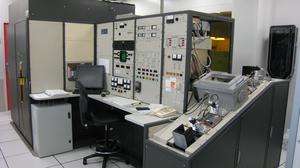Implantation Ionique
The ion implantation field is interested in the synthesis and modification of the physico-chemical and/or structural properties of materials by ion implantation techniques with or without thermal treatments. The treatments carried out will lead to structural or chemical rearrangements which will result in modifications of the properties of the treated material. The know-how in this field includes
-localized doping and isolation processes
-localized synthesis of materials
- electrical reactivation of the implanted chemical species
- crystallization of metallic films
- the formation of ohmic contacts
Sample size: from 1 cm2 at the usual sizes: 2, 3 and 4 inches.
The EATON-AXCELIS GA 3204 implanter is "a medium-current implanter" dedicated to localized doping and isolation processes.
Eléments implantés: As, P, Si, He, Ar, N, C, B, F. D’autres éléments pourront être implantés, selon les paramètres demandés.
However, we also perform "technology support processes:
- Thus, through judicious use of different co-implants, it is possible to minimize the diffusion of implanted dopants.
- It has been shown the feasibility through the use of high doses and proper annealing, to perform the localized synthesis of a material like GaN from GaAs.
- By implantation of heavy ions in a particularly "chemically stable" material case of superconductors, GaN... it has been observed that the etching of these, are facilitated.
Other examples are available, which makes us say that the implementation is used in our laboratory as a "technology support tool".
Rapid heat treatments
Two furnaces (Jipelec JetStar 100S furnace, Annealsys As-One furnace) allow us either to proceed to the electrical reactivation of most chemical species implanted, with a partial or total cure of the defects created during the implantations; or to proceed to thermal treatments in order to carry out a precipitates growth leading to the elaboration of materials of particular structure.
- Temperature range: 100 to 1200°C
- Susceptors: Silicon or graphite coated with SiC
- Atmosphère : azote ; azote-hydrogéné ou vide primaire
- Sample size: up to 6 inches
Contact: Laurent Fugère, Dmitri Yarekha















